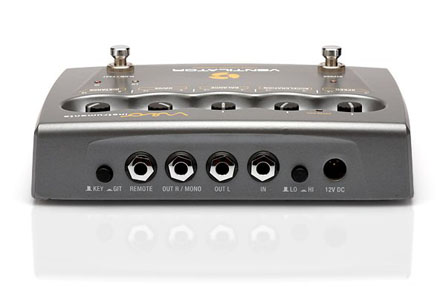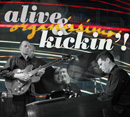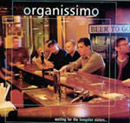Review - The Ventilator, page 2
by Jim Alfredson
IN USE - ORGAN
My road rig for the past two years consists of a Hammond XK3 with the XK Traditional System and a Leslie 3300. I love the Leslie 3300 and I'm a firm believer that nothing can fully replace the experience of real moving air. But sometimes situations arise where there's no space in the vehicle for a real Leslie, or the stage is just too small. In those instances, I've always wished I could use the XK3's onboard Leslie simulator, but frankly it is… well, terrible. I love Hammond-Suzuki products and I'm a proud endorsee of the company, but they unfortunately dropped the ball with the Leslie sim in the XK3. Thankfully, they rectified the issue with the XK3c and the XK1. The onboard Leslie sims in those models are much improved and sound very good indeed. I don't own an XK3c or XK1, however, so I can only compare the Ventilator to the XK3.

Fig 1.1 - The Ventilator back panel
Before listening to the Ventilator I decided to reacquaint myself with the XK3's onboard sim and tweak some settings to see if I could make it useable. The results were not very good and I quickly became frustrated at my inability to coax a decent sound from the XK3. I'm so used to playing it through the Leslie 3300, which sounds amazing, that I wasn't used to hearing it sound so bad.
Ventilator to the rescue! When I connected it to the XK3, in mono at first, the difference was staggering. In fact, it was so exaggerated, I finally realized why the XK3 simulator falls so short.
To me, the XK3 sim sounds like a Leslie without the cabinet. It's almost as if two perfectly engineered speakers were rotating in an anechoic chamber, rather than a wood enclosure in a room. It has no depth, no space, no "woodiness", and barely any amp simulation. It doesn't affect the tone of the XK3 at all, it just makes it “spin”.
This was further illustrated by what the Ventilator did to the high-end of the XK3. For those that have my custom tonewheel set, you probably noticed the key-click is very bright if you're not going through a real Leslie. If you've ever heard a direct line off a real tonewheel Hammond , you'll recognize that characteristic. It's bright and "tinny" with a lot of key-click. That's what makes the XK3 so great! The raw sound of the XK3, once properly tweaked, is remarkably close to the raw sound of a classic tonewheel Hammond , closer than any other clone before. Hammond and Leslie tone cabinets tend to mask that brightness and impart their own flavor on the sound, which is why the XK3 is amazing through a real Leslie.
The Ventilator affects the raw sound of the XK3 just like a real Leslie. It was simply stunning. There was depth and motion and a space to the sound. Plugging the output of the Ventilator in stereo intensified the experience even more.
Time to tweak the knobs, which were all set in the 12 o'clock position. The knobs are always active (there are no presets even though the unit is digital) and have a really great smooth feel to them. I started with BALANCE, which changes the balance between the level of the low rotor and high rotor. I dialed in just a bit more upper rotor, nudging it to around +2 or so. Then to the DRIVE, which goes from subtle grunge to Jon Lord territory with ease. Even better, it sounds great throughout the entire range without ever getting harsh or digital sounding. I finally settled on the DRIVE knob at about +2.5, adding just a hint of color to the sound when I pushed the expression pedal. Next I played with the DISTANCE knob, which affects how close the virtual mics are to the cabinet. I found that I wanted the “mics” to be a bit closer, around +4 on the dial, to emphasize the movement of the rotors.
For fun, I turned on the internal reverb of the XK3 and hit a series of staccato notes. Putting reverb through a Leslie can sound really weird but in the case of Leslie simulations, I find it can reveal interesting limitations in the realism of the 3D image (ie the movement of the rotor towards and away from you). With the reverb, I could really hear the rotors moving in a three dimensional space. Very impressive yet again!
I didn't mess with the SPEED knob because the ramp up and ramp down of the Ventilator sounded very legit to me. All in all, the Ventilator really imparted the effect of having a Leslie 122 mic'd up in stereo and ready to record as I listened under headphones. The virtual bottom rotor slowing down was especially spot on perfect!
I decided to try the Hammond CU-1 Leslie switch that I normally use with the XK3 and connected it to the REMOTE jack on the back of the Ventilator. The three position toggle switch not only gave me the slow (chorale) and fast (tremolo) speeds but also provided a stop (brake) as well in the middle position, just like with my 3300. Excellent!



